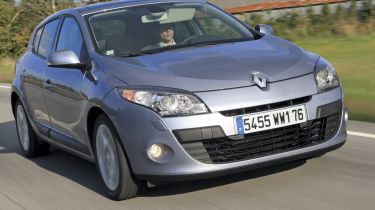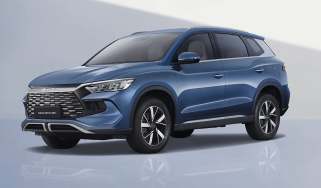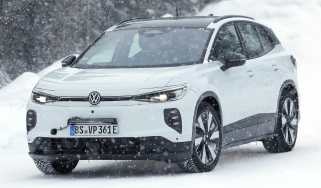Renault Megane 1.5 dCi
Latest-generation hatchback tones down the style, but brings a host of improvements.

The third-generation Mégane is a vast improvement. The 1.5-litre dCi variant is competent in every area – it’s comfortable, drives well, looks good, feels well built, performs admirably and is frugal. Yet the outgoing car’s trump card – its unique look – has gone. And the next Mégane can’t match the quality of the Golf MkVI, nor the driving experience of the Ford Focus. The forthcoming Coupé will add a touch of visual flair, but only time will tell if the Mégane can excel against some very tough opposition. It’s close to the best, but it’s not the class leader.Rival: Ford Focus 1.6 TDCiFamily hatches don’t get much better than this. The diesel Focus is frugal, performs well and its dynamics are the best in class. The Mégane is good – however, we still prefer Ford’s contender.
The family hatchback sector is the most competitive in the Europe. So, to compete with a raft of top-quality opposition, it’s vital for Renault to get the new Mégane right. The latest Volkswagen Golf raises the bar for quality and refinement in the sector, and the dynamic prowess of the Ford Focus makes it the one to beat for sheer driving fun. So we’ve driven the 1.5 dCi Mégane to see if it can challenge the best in class.
Used - available now

2020 Ford
Kuga
21,394 milesManualDiesel1.5L
Cash £15,197
2023 Citroen
e-C4
23,482 milesAutomaticElectric
Cash £12,697
2022 Kia
Sportage
19,022 milesManualDiesel1.6L
Cash £21,197
2022 BMW
3 Series
30,516 milesAutomaticPetrol2.0L
Cash £20,997Let’s start with the looks. The outgoing model’s angular styling and jutting rear end caused controversy, although its uniqueness also won it plenty of fans. Yet the most striking thing about the new car is how much more conventional its styling is. Nowhere near as challenging, it has a low, wide stance and more conventionally handsome proportions. A version of the outgoing car’s chassis has been used, but it’s modified to make the model wider and longer. Inside, the dashboard has an understated elegance, with soft-touch materials in the upper half. Thoughtful details include chrome accents on the door handles and a rubberised feel to the centre console.
Finding a comfortable driving position is easy, thanks to plenty of seat and wheel adjustment. The instrument panel combines analogue and digital information. A centrally placed speedo displays large, dark numbers against a light background, and integrates a gearshift indicator along with a speed limiter – which goes from a static green to a flashing red to indicate the selected maximum has been reached. Elements from the Laguna saloon include hands-free entry and an electric parking brake
Trims
Three trim levels will be available – Expression, Dynamique and Privilège. The second is pitched as a sporty version, while the third is the flagship. Across the range, perceived quality is leaps ahead of the outgoing car’s. And, with a 405-litre boot, the newcomer claims class-leading luggage space.
As with the current Mégane, the suspension set-up comprises MacPherson struts at the front and torsion beams at the back. However, the set-up has been lowered and revised for superior overall responses and more communicative steering. In fact, feedback through the wheel is a highlight.
Completing the upgrade, there are larger disc brakes for improved stopping power. These are a definite improvement over those of the outgoing car. And, once again, the 1.5-litre diesel unit leaves a positive impression. It doesn’t throw you into the back of your seat, but responds smoothly from 1,800rpm – and it’s frugal. The six-speed gearbox has a clean precise change, while the ride is a good compromise between comfort and stability.
We also got behind the wheel of the 2.0-litre turbo petrol variant, which is even more impressive thanks to stiffer springs and dampers. The result is stable handling even when close to the limits, while the motor is fully alive and kicking after 1,900rpm, pushing on strongly all the way to 5,500rpm. It suffers from some turbo lag under hard driving, however, and would benefit from shorter-throw gearshifts.
As the likely big seller, the 1.5-litre diesel variant impresses with its mix of frugality, acceptable performance and genuinely enjoyable driving experience.



